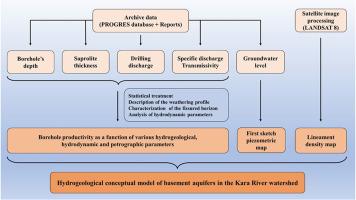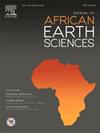利用水文地质档案数据增进对西非硬岩含水层的水动力知识
IF 2.2
4区 地球科学
Q2 GEOSCIENCES, MULTIDISCIPLINARY
引用次数: 0
摘要
在卡拉河流域(KRW,多哥北部),饮用水主要由流经达荷美山脉变质地层裂隙的地下水提供。这项研究基于对 20 世纪 70 年代至 2021 年水文地质档案数据集的使用和估价。该数据库包括 1389 个钻孔,但经过预处理后只考虑了 710 个钻孔,主要提供了总深度、风化厚度、钻孔排水量、压水位、比排水量、渗透率和所挖掘岩性的信息。研究方法包括数据统计分析、裂隙地层特征描述、建立水动力参数之间的关系以及卫星图像处理。研究结果表明,含水层的结构与世界各地在硬岩环境下观察到的含水层结构相近,并提供了在西非特定环境下这些环境的水文地质功能的操作细节。含水层从地表向下依次为:作为储水层的钠长石层(厚度在 0.2 至 37.3 米之间)、渗透性取决于裂隙数量和连通性的裂隙层以及渗透性极低的未裂隙基岩层。在研究区域,有用的裂隙介质深度为 52 米,平均有用排水量为 7.1 立方米/小时。比排水量和渗透率的变异系数大于 100%,反映了研究区域的结构异质性。根据岩性对钻孔中测得的排水量进行的分析表明,玄武岩比其他地质构造的排水量更大。最后,利用所有地质、水文地质和水动力数据,提出了流域硬岩含水层的初步概念模型。这些结果将作为水资源管理者的决策工具,并将促进韩国西部地区地下水资源综合管理政策的制定。所开发的方法还说明了应如何利用档案数据,在不进行重大投资的情况下实现含水层的优化管理。本文章由计算机程序翻译,如有差异,请以英文原文为准。

Using archive hydrogeological data to enhance the hydrodynamic knowledge of hardrock aquifers in Western Africa
In the Kara River Watershed (KRW, northern Togo), drinking water is mainly supplied by groundwater flowing through fissures in the metamorphic formations of the Dahomeyides belt. The study was based on the use and valorisation of hydrogeological archive dataset from 1970s to 2021. The database comprises 1389 boreholes, but only 710 are considered after pre-treatment, and provides information mainly on total depth, weathering thickness, discharge at drilling, piezometric level, specific discharge, transmissivity, and the nature of the lithology tapped. The methodological approach involved statistical analysis of data, characterization of the fissured horizon, establishment of relationships between hydrodynamic parameters and satellite image processing. The results showed that the aquifers structure is close to those observed worldwide in hardrock context and they provide operational details on the hydrogeological functioning of these environments in the West African particular context. From the surface downwards, aquifers show a layer of saprolite (thickness between 0.2 and 37.3 m) acting as a storage level, a fissured layer whose permeability depends on the number and connectivity of the fissures, and then a level of very low permeability, unfissured bedrock. In the study area, the depth of the useful fissured medium is 52 m with an average useful discharge of 7.1 m3 h−1. The coefficients of variation for specific discharge and transmissivity are greater than 100%, reflecting the structural heterogeneity of the study area. Analysis of the discharges measured in the boreholes as a function of lithology shows that the metasediments are more productive than other geological formations. Finally, all the geological, hydrogeological, and hydrodynamical data have been used to propose a preliminary conceptual model of the watershed's hardrock aquifers. These results will serve as decision-making tools for water managers and will facilitate the policy of integrated management of groundwater resources at the scale of the KRW. The developed methodology also shows how archive data should be used to achieve optimized management of aquifers without major investments.
求助全文
通过发布文献求助,成功后即可免费获取论文全文。
去求助
来源期刊

Journal of African Earth Sciences
地学-地球科学综合
CiteScore
4.70
自引率
4.30%
发文量
240
审稿时长
12 months
期刊介绍:
The Journal of African Earth Sciences sees itself as the prime geological journal for all aspects of the Earth Sciences about the African plate. Papers dealing with peripheral areas are welcome if they demonstrate a tight link with Africa.
The Journal publishes high quality, peer-reviewed scientific papers. It is devoted primarily to research papers but short communications relating to new developments of broad interest, reviews and book reviews will also be considered. Papers must have international appeal and should present work of more regional than local significance and dealing with well identified and justified scientific questions. Specialised technical papers, analytical or exploration reports must be avoided. Papers on applied geology should preferably be linked to such core disciplines and must be addressed to a more general geoscientific audience.
 求助内容:
求助内容: 应助结果提醒方式:
应助结果提醒方式:


